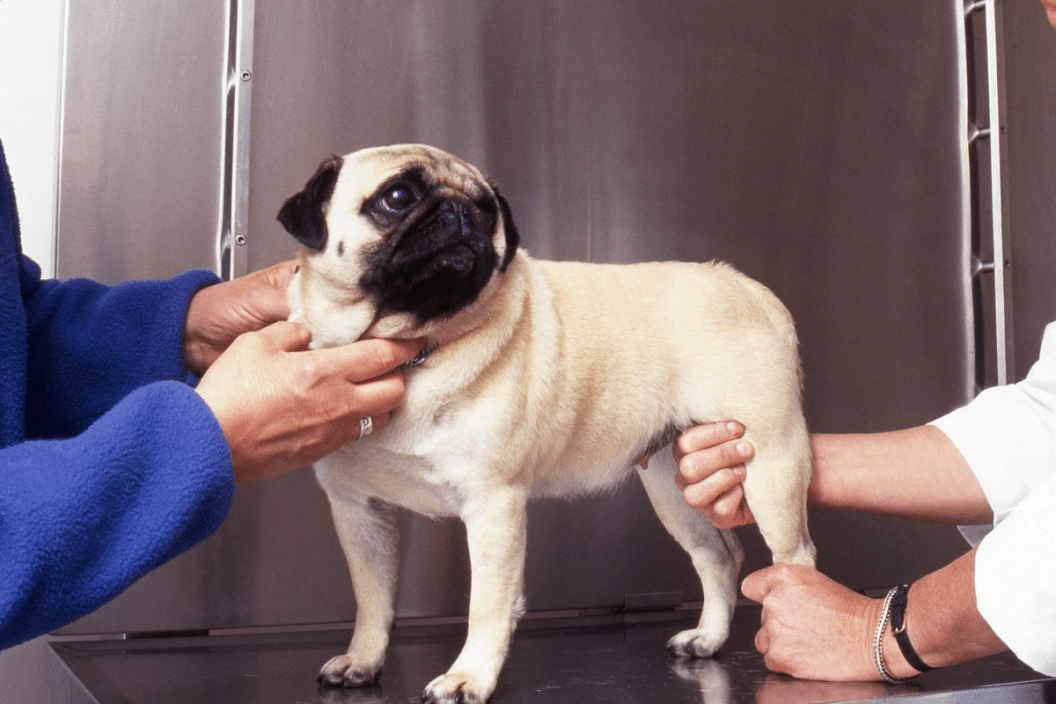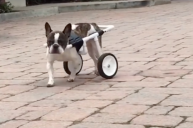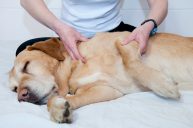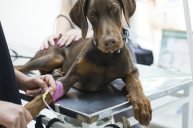Home remedies for hip dysplasia can help make your dog's life better. Hip dysplasia can be painful for your pup and painful on your wallet. It may affect one or both of your dog's hips, and surgery is expensive and uncomfortable.
Dysplastic hips are one form of canine degenerative joint disease (DJD). Puppies mature rapidly, with most dog breeds reaching full size within 8 to 18 months of age. Unfortunately, this accelerated growth raises the risk of certain diseases and accidents, such as hip dysplasia, a degenerative condition in which a dog's hip joints develop abnormally.
Hip dysplasia causes severe symptoms such as pain and mobility issues and is especially common in large breeds of dogs. However, there are home remedies for canine hip dysplasia that can alleviate the pain without resorting to surgery.
What is Canine Hip Dysplasia?
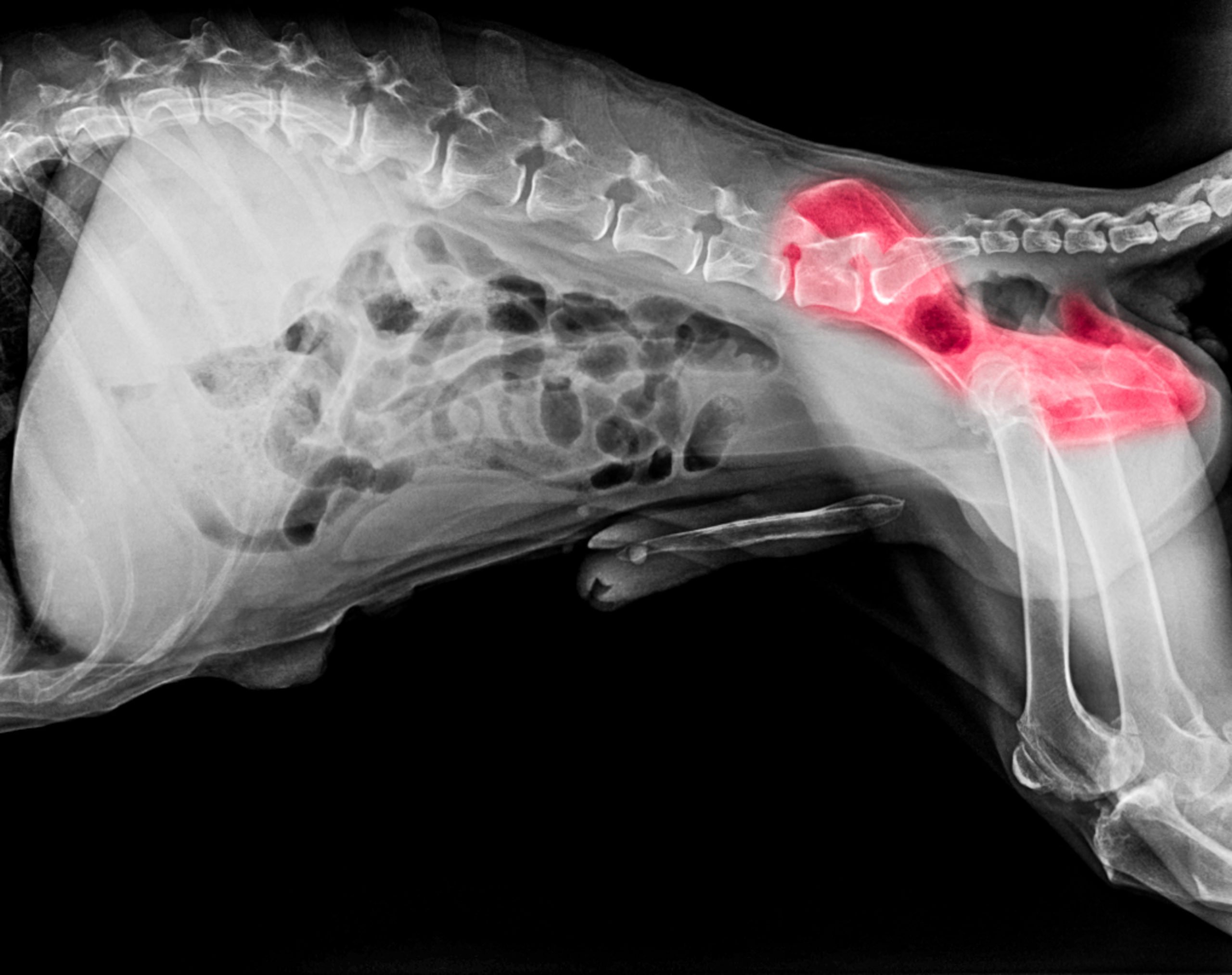
X-ray film of dog with red highlight in hip bone pain area where hip dysplasia occurs. (Adobe Stock)
The hip joint of a dog is made up of a rounded hip socket into which the ball of the femur (the highest leg bone) fits. Hip dysplasia develops when the hip socket is too shallow, or the femur head is deformed, resulting in a weak link and premature cartilage wear. This disorder can also cause painful hip inflammation (osteoarthritis). Dysplasia is a medical term that refers to irregular growth or structure. Since the cup created by the pelvic bone is too small in dogs with canine hip dysplasia, the leg bone and pelvic (hip) bone do not fit directly into the opening, causing the leg bone to dislocate as it slides out of the pelvic socket. Your dog can develop painful arthritis.
Large breed dogs, such as German Shepherds, Great Danes, Labrador Retrievers, and Saint Bernards, are most susceptible. Hip dysplasia's symptoms include a limited range of motion, lameness, difficulty getting up, shifting their weight from one leg to another when standing or moving, waddling, limping, "bunny hopping," or falling over when squatting. Dog owners who notice any of these symptoms should take their dogs to the vet. They may order x-rays to confirm their diagnosis.
Many vets may recommend a total hip replacement, but surgery is not the only way to treat hip dysplasia. There are holistic treatment options for improving your dog's quality of life that doesn't involve an expensive and stressful surgery to treat their hip dysplasia. These methods include supplements, lifestyle changes, and physical therapy.
Home Remedy 1: Supplements
A dog's life with hip dysplasia can be significantly improved by using supplements and nonsteroidal anti-inflammatory drugs (NSAIDs) to reduce joint pain. Over-the-counter NSAIDs, such as ibuprofen, can provide pain relief for your dog's hip dysplasia. Also, joint supplements can reduce hip pain. Omega-3 fatty acids, such a fish oil, are good for joint inflammation relief. Additional supplements, such as glucosamine, hyaluronic acid, and chondroitin, are also recommended to refuse joint inflammation and pain. Your dog may not enjoy the taste, but tablets and pain medication can be crushed and mixed with dog food if necessary. Monitor your dog for any potential side effects.
Home Remedy 2: Physical Therapy
Your dog's pain can also be managed by physical therapies such as acupuncture and hydrotherapy. Many dog owners have used acupuncture to treat their dog's joint pain successfully. There is a documented connection between acupuncture points and nerve pathways in the body; stimulating an acupuncture point can help alleviate joint and limb pain. Besides, hydrotherapy, such as swimming, is a low-impact exercise that is especially good for dogs with joint pain. If you don't have a large pool or body of water nearby, an inflatable backyard pool can do the job.
Home Remedy 3: Lifestyle Changes
Finally, lifestyle changes can be one of the most important home remedies for canine hip dysplasia. Changes such as include monitoring your dog's weight, using a soft dog bed, and getting regular exercise can make a huge difference in improving your dog's quality of life and reducing their hip pain. Obesity can increase the pain and pressure in your dog's joints; watching their food, switching to a higher-quality type of dog food, and taking them for regular walks and playtime will prevent any additional stress on their joints. A soft dog bed in their kennel or sleeping area can also prevent stress on their joints while sleeping/resting.
